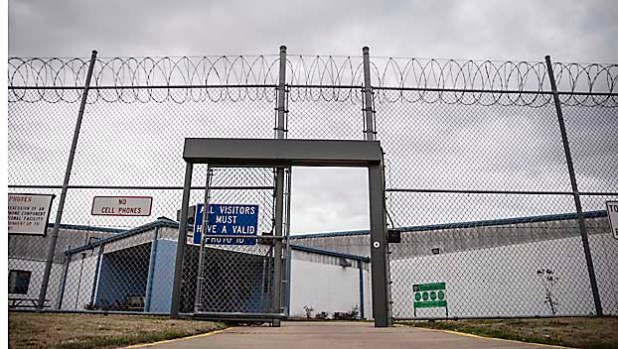Think debtors prison is a thing of the past? Not in Mississippi where it’s pay up or get locked up
Published 5:16 pm Thursday, January 9, 2020
During her shifts at a Church’s Chicken, Annita Husband looked like the other employees. She wore the same blue and red polo shirt, greeted the same customers, and slung the same fried chicken and biscuits.
But after clocking out, Husband, a mother in her 40s, had to wait for a white van with barred windows and the seal of the Mississippi Department of Corrections on its sides. It delivered her to the Flowood Restitution Center, a motel converted into a jail surrounded by razor wire, nestled among truck stops and an outlet mall. Here, Husband slept in a room with seven other women, sharing a mirror to get ready in the mornings, enduring strip searches for contraband at night.
A judge sentenced Husband to the restitution center in 2015 to pay off almost $13,000 she owed from an embezzlement conviction in 2009. The corrections department would not release her until she earned enough money at her $7.25-an-hour part-time job to clear her debts and cover $11 a day for “room and board” at Flowood.
“If I wasn’t at work, I was in prison,” Husband said.
The corrections department took her paychecks, she said, giving her back just $10 a week—all in quarters—so she could buy things like soap and deodorant.
The state of Mississippi had locked Husband into a modern-day debtor’s prison. She had other plans.
‘It’s a form of penal labor’
Mississippi appears to be the only state where judges lock people up for an indefinite time while they work to earn money to pay off court-ordered debts. While there is no comprehensive data, legal experts who study fines, fees and restitution say Mississippi is unusual at the very least.
“We don’t know of any other states that have a program quite like Mississippi’s,” said Sharon Brett, a senior staff attorney with Harvard’s Criminal Justice Policy Program.
A handful of states experimented with restitution programs starting in the 1970s, but abandoned them as expensive and ineffective.
Not Mississippi. Judges have sentenced hundreds of people a year to four restitution centers around the state, almost always ordering the inmates to stay until they pay off court fees, fines and restitution to victims, according to four years of government records analyzed by Mississippi Today and The Marshall Project.
People sent to the centers had been sentenced for felonies but didn’t commit violent crimes, according to the program rules. When we tracked down the cases of more than 200 people confined there on Jan. 1, 2019, we found that most originally got suspended sentences, meaning they did not have to go to prison.
They didn’t usually owe a lot of money. Half the people living in the centers had debts of less than $3,515. One owed just $656.50. Though in arrears on fines and court fees, many didn’t need to pay restitution at all—at least 20 percent of them were convicted of drug possession.
But inmates spent an average of nearly four months—and up to five years—at the centers, working for private employers to earn enough to satisfy the courts. Meanwhile their costs continued to balloon, since they had to pay for room and board, transportation to their jobs, and medical care.
They didn’t get paid much. Between 2016 and 2018, workers at the centers made an average of $6.76 an hour in take home pay, according to our analysis of state data.
It’s a futile system that penalizes the poorest residents of the poorest state in the country, said Cliff Johnson, director of the MacArthur Justice Center at the University of Mississippi.
“Debtors prisons are an effective way of collecting money—as is kidnapping,” he said. “But there are constitutional, public policy and moral barriers to such a regime.”
Many states are reconsidering the practice of jailing the poor, especially because of its inordinate impact on people of color. Since 2018, Mississippi has required judges to find that people willfully failed to make court-ordered payments before sending them to jail or prison.
But that hasn’t affected the number of people entering Mississippi’s restitution center program, which our reporting shows mostly affects those on probation for low-level offenses related to drug addiction or poverty.
Mississippi Today reviewed hundreds of documents, spoke with more than 50 current and former restitution-center inmates and interviewed legal experts over the course of 14 months.
Our investigation with The Marshall Project found:
- Black people are overrepresented at restitution centers, accounting for 49 percent of inmates, compared with 38 percent of the state population, according to our analysis of center data for January 2019. More than 60 percent of people in prison in Mississippi are black.
- The inmates work at low-wage, sometimes dangerous jobs, such as slaughtering chickens or gutting catfish at processing plants. Private citizens hire them to work as handymen and landscapers at their homes.
- When inmates can’t get jobs, sometimes for medical reasons, they sit in the centers, accruing $330 a month in room and board costs. Some of them say the centers don’t offer programs to deal with addiction or earn high-school diplomas.
- Just a quarter of all money earned by the inmates went to pay restitution, with the remainder going to the corrections department and the courts, according to state data from July 2014 through June 2018. In some cases, the courts added unrelated debts, such as child support. One man’s charge for meth possession turned into debt totaling $72,500.
- Inaccurate and confusing record-keeping by the state makes it hard for inmates to know if they are making progress toward paying off their debts and how soon they might be eligible for release.
The Mississippi Department of Corrections, or MDOC, repeatedly declined our requests to visit the restitution centers and to discuss them with state officials. But in a statement issued in late December in response to our findings, the department noted that it follows state law when operating the restitution program.
Emphasizing that judges are in charge of sending people to the centers, the statement says the program “provides an alternative to incarceration for minimal risk offenders by facilitating their transition to the community.”
“While individuals in this program are required to work, the MDOC does not force them to work,” the statement says. “The MDOC merely assists them in finding employment.”
The state has a long history of forcing prisoners—especially black men—to work. After slavery was abolished, Mississippi leased a soaring number of prisoners to private industry. Public outcry over deaths and mistreatment forced the state to end that program in 1890. Mississippi then founded the state penitentiary known as Parchman Farm, which was modeled after a slave plantation. It still houses over 3,000 of the state’s 21,000 prisoners.
The restitution-center program has unfortunate parallels with Mississippi’s past, said Alex Lichtenstein, a historian who has written a book on convict leasing in the South. “It’s a form of penal labor, there’s no question about it.”
Today, employers benefit from access to cheap and reliable labor from the restitution program. “If it weren’t for the restitution center, I would seriously have trouble running my business,” said Barry Porter, the owner of a Sonic Drive-In near Jackson. Several inmates described him as a fair and accommodating boss.
Some judges say the program helps those sentenced to it. Charles Webster, a circuit judge in Clarksdale, said that the program teaches them about responsibility by requiring them to show up for work and meet financial obligations. He had sentenced two of the people in the centers in January 2019.
“Going to the restitution center’s better than going to prison, I would think,” he said.
Bring in money or ‘you’re going to jail’
One June morning in 2007, while Husband worked at a payday loan store near Biloxi on the Gulf Coast, she looked at a surveillance monitor and watched as the dealership repossessed her white Chevrolet Suburban.
Like many of her clients, Husband lived paycheck to paycheck. Supporting three sons and her injured spouse on her own, she had fallen behind on making her monthly payments.
To get the truck back, she began creating fake loans, pocketing about $11,000 in cash from her employer, Money Now. Several weeks later, an internal audit uncovered the scheme. Husband, who in the past was convicted of writing bad checks and of stealing $300 from Sears, pleaded guilty to embezzlement. She was sentenced to seven years in prison.
But the judge allowed her to serve five years of probation instead as long as she paid $50 a month to the corrections department for monitoring her, plus $200 a month toward her fines, fees and restitution.
Over the years, she struggled to keep up with the payments as she worked at mostly low-paying housekeeping jobs at hotels and cared for her husband until he died in 2009. She said her probation officers threatened her: “‘Next time you come in and you don’t have any money, you’re going to jail.’”
Fearing she would be thrown in prison for nonpayment, she stopped reporting.
This led to a cycle of probation violations that landed Husband in jail for weeks and on house arrest in 2011. In 2015, she was back in court again. When she explained her fears of being imprisoned for failing to pay, the judge replied, “That’s no excuse for not reporting to your probation officer where they can keep up with you.”
Judge Roger T. Clark told Husband she had to “attend and successfully complete the restitution center program” at Flowood, according to the hearing transcript. But the court order he signed spelled out something more: She had to stay until she paid her $12,685.50 balance—restitution, fines and fees— with the court.
The restitution center was 170 miles from her home in Biloxi. When Husband arrived at the work camp in May 2015, she called one of her sons to let him know she had made it.
“He said, ‘Happy Mother’s Day,’” Husband said. “It was just so hurtful, because here I am, basically in prison.”
Judges are at the heart of the system. Three judges accounted for almost a third of the people at the restitution centers in January 2019. Clark and a colleague also on the coast, Judge Christopher Schmidt, declined to comment. Judge Dal Williamson, of Jones County in south Mississippi, said he typically sends people to the restitution center when they have refused to pay their debts. “And you’ve got a victim out there that needs to be made whole.”
It’s the sentences—for a dollar amount rather than a period of time—that make the restitution center program so unusual, and so onerous, inmates and experts agree.
Our review of orders for more than 200 people revealed that judges sent about 80 percent to a center for violating the terms of their probation. In 16 orders, the only violation listed was the defendant’s failure to pay. Almost all of the inmates were given a specific amount of money they must earn before their release. In 15 cases we found, the judges sentenced defendants to the restitution centers for an amount of money and a time limit of 90 days to three years.
Plotting an escape
While Husband was at the restitution center, the state didn’t call her an inmate (it uses the word “resident”), and she did not have to wear a striped prison uniform. Flowood does house women finishing prison sentences who perform community service for government agencies and local charities.
But Husband and the 36 other women at the Flowood restitution center at the time slept on the same prison-issued mattresses, ate the same food, and had to follow most of the same restrictions as the other prisoners.
Even when they’re at work, restitution program inmates are not allowed to see friends or family, talk on the phone or smoke cigarettes. At the centers, they are assigned chores —Husband said she cleaned the center’s vans and washed dishes after meals.
Like others, she had no idea how much money she was accumulating or how long it would take to pay her way out. Inmates can get printouts showing debits and credits in their accounts, which the state calls a monthly balance sheet. But they find the information hard to interpret.
Husband said she couldn’t stop thinking about someone she met who had been in the center for two years, trying to pay off $2,000. She began plotting her escape.
On July 9, 2015, Husband got up before the other women in her room, she said. She put on jeans and a white Nike T-shirt under her Church’s Chicken uniform. She called the restaurant to tell her supervisors she would be taking the day off.
Husband rode with other residents in the back of a white prison van from the Flowood compound until they reached the Church’s Chicken. It’s at Jackson’s Freedom Corner, a civil rights landmark honoring the intersection of Martin Luther King Drive and Medgar Evers Boulevard.
The van dropped her off before the restaurant opened. Husband asked a coworker to drive her to downtown Jackson. She had already exchanged her quarters for $5 bills that she smuggled into the center by rolling them tight in her ponytail. Now, she used that cash to buy a ticket at the Greyhound station.
Then she hopped on the first bus headed down to the Coast—and home. She was one of roughly 70 people who ran away from the restitution centers each year between 2015 and 2017, according to state data.
“I wasn’t even thinking about those fines anymore,” she said. “I was just thinking about, ‘I got to get out of here.’”
‘Just for the sake of justice’
Two months after Husband escaped, the corrections department sent $1,179 to the Harrison County court. At the rate she was earning money, Husband would have spent more than a year and a half in the restitution center working to pay off her debts, according to our analysis of her earnings reports.
As an inmate makes money, the corrections department takes the first cut in room and board, then usually holds the remaining earnings until there’s enough to pay the entire debt. When someone leaves the program, the corrections department sends their earnings to the court to cover its costs. It distributes the rest to victims, then to pay criminal fines.
In Husband’s case, the payday lender she stole from received just over $600 in restitution, according to county records. Paul Goldman, who runs Money Now, told Mississippi Today that he rarely receives restitution when he deals with worker embezzlement at one of his family business’s two dozen locations.
Without repayment, Goldman said, he wants to see those employees locked up. “Just for the sake of justice.”
About six months after Husband left Flowood, officers found her when a son crashed her car and, not knowing she was evading law enforcement, gave them her address, she said.
A judge sentenced her to her original prison term. She spent almost 10 months at Central Mississippi Correctional Facility in rural Rankin County.
That’s about half as long as she would have spent at the restitution center.
In the years after she left prison, Husband said, she met with her parole officer each month and paid what she could, usually $20 a visit. She still owed more than $10,000 when she finished parole in September, more than a decade after she was first sentenced for her crime. Husband’s criminal case is closed.
Now 52, Husband lives in a small apartment surrounded by palm trees. She works two jobs as a hotel housekeeper, she said, earning about $25,000 a year for 55 to 60 hours of work every week.
Looking back, Husband said she was punished for being poor, saddled with debts she could never repay. She called her time in prison bittersweet. She felt embarrassed to be there, but relieved to know that when she got out, she would be finished with her punishment at last.
In the restitution center, “You’re there without an end. You do not know when you’re getting out, when you’re going to be finished,” she said. “That’s torture.”
Anna Wolfe is an investigative reporter who writes about poverty and economic justice for Mississippi Today, an independent nonprofit newsroom.
Michelle Liu has covered criminal justice issues for Mississippi Today through the Report for America initiative since June 2018.
Andrew R. Calderón is a data reporter for The Marshall Project.
This investigation was published in partnership with The Marshall Project, Mississippi Today, USA TODAY Network and the Jackson Clarion-Ledger.








